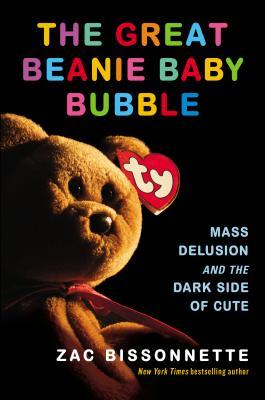This week I'm taking a look at something a little...unusual, although it's definitely tying in with my interest in economic bubbles and especially the disasters that occurred in the 1990's when America apparently lost its goddamn mind. And there is perhaps no better example of this than the Beanie Baby craze which emerged seemingly out of nowhere and then disappeared just as quickly. TY Inc. remains the largest producer of plush animals in the world, and owner Ty Warner has remained a billionaire. However, Ty is extremely reclusive and has not given an interview since 1996 and company provides even less information than, as the author points out at the beginning, basically saying, ''Hey, remember how Beanie Babies were a thing? We made those!'' So tracking down information on this subject, as well as the origins of the mania, can be rather difficult but Bissonnette manages to make at least some revelations into the darker sides behind the adorable stuffed animals that took America by storm.
At the center of the story is, of course, Ty Warner, but the image that emerges is of a deeply troubled man with numerous problems including an overinflated ego. (As people like to point out, there's a reason the company's logo is a heart with Ty's own name in it.) On the one hand, Ty Warner was a savvy salesman and an absolute perfectionist who agonized over every stuffed animal design to create the cutest and best quality animals for the lowest price. And the idea behind Beanie Babies was, initially, rather ingenious. Adorable bean bag animals purposely understuffed so kids could pose and play with their animals and small enough to slip into a backpack to bring to school to show all their friends. From a creative standpoint Warner's perfectionism was an absolute boon. However, perhaps largely of his childhood, Warner was also extremely emotionally manipulative, trying to gain power in every situation and beating the smaller retailers he exclusively sold Beanie Babies to in submission because of their dependence on a hot-selling item. His ego made him write everyone who ever helped him on his journey out of the story of his success. From his father to his girlfriends to a young girl who helped him design Spook the Ghost, Ty erased all of them from the narrative and made the success of Beanie Babies all his own.
The story of how Beanie Babies became a sensation is somewhat more complex. Part of it was just the nature of the animals themselves. Warner, never satisfied with his products, would update models to make them better. Quackers the Duck originally came without wings, for example, which was later rectified. Other animals, such as Humphrey the Camel, were difficult to produce and if they weren't terribly popular were discontinued. However, in a brilliant marketing twist, salespeople and later Ty began calling these discontinuations ''retirements'', which made the ending of a product more exciting for people. And as people began building collections of Beanie Babies there became a market for rare or hard to find Beanie Babies, especially earlier models of popular animals or retired animals. Originally a toy for kids, moms began building their collections and, through the power of eBay, prices for rare animals began climbing to ten or twenty dollars and eventually grew to hundreds or thousands of dollars.
As word of people actually making money off of buying and then reselling $5 stuffed animals, especially helped by the media and persistent hype, the whole thing became a speculative bubble. Because Warner distributed exclusively through smaller retailers and kept supply artificially low, demand remained incredibly high and people would pour thousands of dollars into purchasing Beanie Babies, hoping to get fat pay offs in the future. People actually touted Beanie Babies as investments as good as stocks or bonds and people, especially poorer people, poured money into accumulating hundreds or thousands of Beanie Babies assuming they'd secure the well-being of their children. Ironically the main purchasers of Beanie Babies ceased to be children and became exclusively the collectors, who immediately sealed the animals away in plastic bins to await their ''inevitable'' rise in value.
However, like so many collectible booms of the late 20th century, the Beanie Babies proved to be an absolute bust. Coins, baseball cards, and comic books all went through speculative bubbles which ultimately crashed. In the case of baseball cards and comic books specifically, the early ones from the 1930's and 1940's were thrown away in large numbers which made copies that survived fairly rare. Because the supply was limited, the price could rise considerably to the point a pristine copy of Action Comics #1 is now worth millions of dollars. Collectibles produced in the 1980's and 1990's, however, were churned out by the thousands. Comic books, baseball cards, and even Beanie Babies were produced in such large quantities that the supply was basically unlimited. Furthermore, with everyone catching the collecting bug, they were all kept in pristine condition which means they're all worth...nothing.
Overall this book is really interesting and there is a certain amount of morbid fascination in people assuming $5 stuffed animals would be as wise an investment as blue chip stocks. (Although the burst of the dot com bubble also brought the wisdom of that investment choice into question.) There is also something heart-breaking about people assuming their collection of Beanie Babies would provide financial security for their son afflicted with cerebral palsy. And while Ty Warner has built an empire in plush animals, he remains an intensely lonely person. I think it's pretty interesting if downright tragic.
- Kalpar


No comments:
Post a Comment